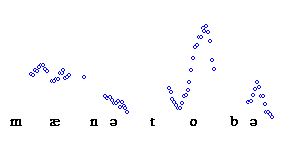- Children will delete unstressed initial syllables more
often than unstressed final syllables. (['næn
 ] is more common
than [b
] is more common
than [b 'næ].)
'næ].)
The following are usually considered suprasegmental properties:
What does it mean for a syllable to be stressed?
A syllable might be more prominent by differing from the surrounding syllables in terms of:
NB: Prominence is relative to the surrounding syllables, not absolute. (A stressed syllable that is nearly whispered will be quieter than an unstressed syllable that is shouted.)
 ] is more common
than [b
] is more common
than [b 'næ].)
'næ].)
 término, 'end' (noun)
término, 'end' (noun)  termíno, 'I'm finishing'
termíno, 'I'm finishing'  terminó, 'she/he finished'
terminó, 'she/he finished' vs.
vs. 
 vs.
vs. 
 vs.
vs. 
E.g., Manitoba
 Pitch
Pitch
 Loudness
Loudness
English typically uses all three kinds of prominence simultaneously. Other languages might use only one or two of them.
The cues can also be used differently is other languages. In Swedish, stressed syllables are usually lower in pitch -- one of the most noticeable features of a Swedish accent.
 Kermit the
Frog pretending he can speak Swedish.
Kermit the
Frog pretending he can speak Swedish.
 Pitch
Pitch
 Loudness
Loudness
Even in English, stress doesn't always mean higher pitch. In one of the intonation contours used to convey surprised disbelief, the most strongly stressed syllable of the utterance has the lowest pitch.
In English, vowels in unstressed syllables are systematically reduced. English speakers will not try to control the position of the tongue body during the vowel of an unstressed syllable. Instead, the tongue body will reach whatever point is convenient in getting from the preceding consonant to the following consonant. The average position reached is mid-central schwa.
Failing to reduce unstressed vowels is one of the major contributors to an accent in non-native speakers of English.
Reducing vowels inappropriately is one of the major contributors to an English accent in other languages.
In general, the differences between stressed and unstressed
syllables are more extreme in English than in most languages.